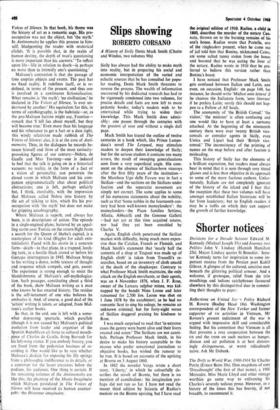Slips showing
ROBERTO CORSANO
A History of Sicily Denis Mack Smith (Chatto and Windus, two volumes 90s)
Sicily has always had the ability to make myth into reality, but in preparing his social and economic interpretation of the varied and eclectic sources that he has consulted for popu- lar reading, Denis Mack Smith threatens to reverse the process. The wealth of information uncovered by his dedicated research has had to be vigorously condensed into two volumes, for precise details and facts are now left to more pedantic books; today's readers wish to be entertained while trying to widen their knowledge. This Mack Smith does admir- ably: one passes through the centuries with the greatest of ease and without a single dull page.
Mack Smith has traced the outline of twelve centuries in a book which, like Prince Lampe- dusa's novel The Leopard, may stimulate readers to deepen their knowledge of Sicily; but for the serious student it contains too many errors, the result of sweeping generalisations seen from a very superficial angle. His com- ment on the absence of Sicilian-born viceroys after the first fifty years of the institution— the Marchese Ugo delle Favare was in fact a Sicilian—and the sections on the Sicilians under fascism and the separatist movement are simply not correct. The same applies to some of his numerous statements about the nobility, such as that 'Some nobles in the fourteenth cen- tury had been well-known moneylenders': the moneylenders—the Pisan families Settimo, Aliatta, Abbatelli and the Genoese Galletti —had not yet at this time acquired estates, nor had they yet been ennobled by Charles V.
Again; English cloth penetrated the Sicilian market with difficulty, being much more expen- sive than the Catalan, French or Flemish, and Mack Smith's statement that 'nearly half the contents of a shop at Trapani was made up of English cloth' is taken from Trasselli's re- searches, based on an inventory of cloth unsold at the death of the shopkeeper. Contrary to what Professor Mack Smith maintains, the only attack on the English merchants, or their agents, was on 4 November 1876, when J. F. Rose, owner of the Lercara sulphur mines, was kid- napped by the bandit Nino Leone and later ransomed for 2,500 lire. Leone was shot on 1 June 1878 by the carabu. tieri; as he had no romantic Scot to sing his eulogy, he remains an unknown criminal, but for forty-eight verses of Sicilian doggerel praising his kindness to Rose.
I was much surprised to read that lirextreme cases the gentry were burnt alive and their livers roasted and eaten.' The Sicilians are not canni- bals. Perhaps Professor Mack Smith, in his desire to make his history acceptable to the masses who prefer sensational journalism to objective books, has wished the rumour to be true. It is based on accounts of the uprising at Bronte on 3 August 1860.
In 1882 the novelist Nerga wrote a short story, 'Liberty,' in which he colourfully de- scribes the revolt of Bronte, but there is no mention of cannibalism : his imagination per- haps did not run so far. I have not read the recent third edition by Sciascia of Radice's memoir on the Bionte uprising, but I have read the imigiSal edition of 1910. Radios, a child is 1060, describes the murder of the notary Can- nata, thrown on to the burning remains of his son's house. Radice wrote that Portella, one of the ringleaders present, when he came out of jail told him that Bonina, nicknamed Caino, ate some salted tunny stolen from the house and boasted that he was eating the liver of the notary. Radice wrote in 1910 that he pre- ferred to believe this version rather than Bonina's boast.
I have noticed that Professor Mack Smith gets confused between Italian and Latin, and even, on occasion, English: on page 149, for instance, he should write 'Mafiosi ante lettera' if he chooses the Italianate form, 'ante litteram' if he prefers Latin; surely this should not hap- pen to a Fellow of All Souls_
The anonymity of 'the British Consul,' the visitor,' the minister' is often confusing and one would like to have at least a surname attached. At the beginning of the nineteenth century there were over twenty British vice- consuls or consular agents in Sicily, even Ustica and Lipari had, their 'British vice- consul.' The inconsistency of the printing of names on the map belore and after fascism is misleading.
This history of Sicily has the elements of a brilliant exposition, but readers must always bear in mind that it is seen through very tinted glasses and is less than objective in its approach to some of the more factious authors. Unfor- tunately, Italians are not completely ignorant of the history of the island and I fear that the reception that these two volumes will have amongst established Italian' historians will be far from laudatory; but to English .readers it may be a trellis on which they can support the growth of further knowledge.






































 Previous page
Previous page